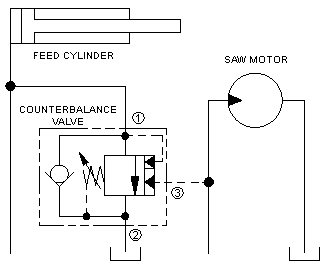Eliminate Stalling While Maintaining Optimum Speed
The cutting device may be a trenching chain, a drill, a grade trimming wheel or a saw. The feed could be a cylinder, a motor or a tractive drive. Typically, an operator will adjust the feed rate so that the cutting device does not stall. The problem with this solution is that when the cutting is easy, productivity is lost. This simple circuit shown below may be a better solution.

Here's how it works:
A counterbalance valve is a direct-acting, pilot-assisted relief valve. Pilot assist at port 3 lowers the effective setting of the relief valve at a rate determined by the pilot ratio. Port 3 of the counterbalance senses the pressure at the cutting device or saw. Port 1 connects to the feed circuit and port 2 goes to tank.
When the pressure required to drive the saw starts to climb too high, the effective setting of the counterbalance is lowered. Feed force will be modulated by relieving the feed circuit to tank, thus preventing the cutting device from stalling.
NOTE: This circuit is all about pressure control as opposed to flow control. Pressure control allows large changes in flow with small changes in pressure. The determining factor in this circuit is the pressure at the cutting device. Don't get too caught up in numbers. There are at least three performance curves involved and trying to predict exactly what will happen is difficult, if not impossible.
In order to serve this purpose, the counterbalance valve has to have enough capacity to handle the flow of the feed circuit. The counterbalance valve will probably need a low pilot ratio and a high setting.
IMPORTANT NOTE: This circuit is presented as one example of how to apply our cartridge valves. It is not a "This package guarantees that your saw will never stall again" package.

